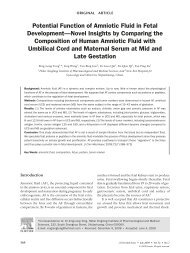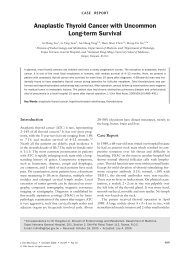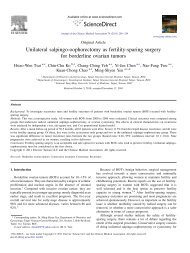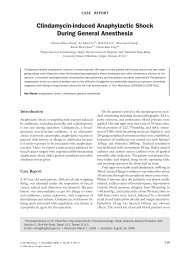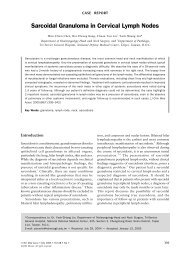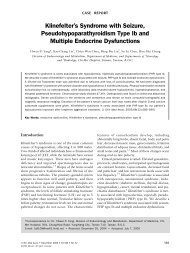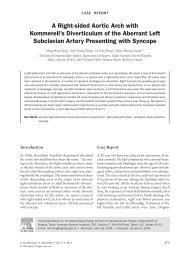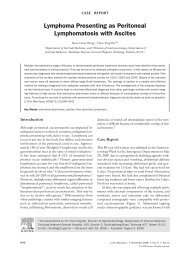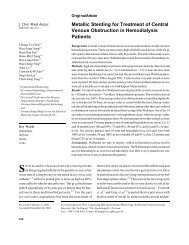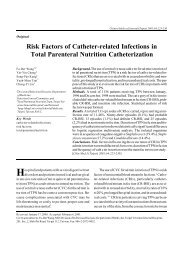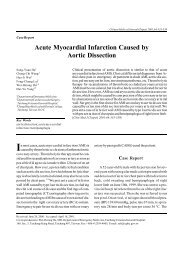Surgical Anatomy of Supratentorial Midline Lesions
Surgical Anatomy of Supratentorial Midline Lesions
Surgical Anatomy of Supratentorial Midline Lesions
You also want an ePaper? Increase the reach of your titles
YUMPU automatically turns print PDFs into web optimized ePapers that Google loves.
Arteries <strong>of</strong> the insula<br />
The frontal branch, which originates from the M 1 segment,<br />
is <strong>of</strong> surgical significance. 34,35 In two hemispheres<br />
(5%), the the LLAs arose from the frontal branch <strong>of</strong> the<br />
M 1 segment (Fig. 2 lower). An aneurysm located in this<br />
region <strong>of</strong> the M 1 segment can be mistakenly diagnosed as<br />
an MCA bifurcation aneurysm. During surgery, a clip applied<br />
to the aneurysm can occlude those LLAs that arise<br />
from the frontal branch, <strong>of</strong>ten close to the origin <strong>of</strong> the<br />
frontal branch at the M 1 segment. This maneuver can result<br />
in postoperative hemiplegia in the patient. It is important<br />
to be aware that LLA can also arise in proximity to<br />
the MCA bifurcation and, occasionally, from the superior<br />
or inferior trunk <strong>of</strong> M 2. The exact location and relationship<br />
<strong>of</strong> these vessels to the aneurysm is an important consideration<br />
to take into account both before and during surgery.<br />
The configuration <strong>of</strong> the LLAs and related arteries can be<br />
determined on detailed angiography, and their location<br />
can be verified at surgical exploration.<br />
Umansky, et al., 29 have described the detailed anatomy<br />
<strong>of</strong> proximal segments <strong>of</strong> the MCA. Their study confirms<br />
that microvascular reconstructive surgeries, such as anastomosis,<br />
grafting, and reimplantation <strong>of</strong> arterial branches,<br />
are viable procedures in the insular area. They observed<br />
that the M 2 segment could be raised 3 to 5 mm without<br />
stretching the pial vessels supplying the insula. They also<br />
noted that the M 2 segment <strong>of</strong>fers potential for performing<br />
a microvascular anastomosis. It is important, however, to<br />
be fully aware which cortical branch <strong>of</strong> the M 4 segment<br />
originates from which trunk <strong>of</strong> the M 2 segment. It is especially<br />
relevant to investigate which trunk <strong>of</strong> the M 2 supplies<br />
the central region. Our observations revealed that the<br />
trunk at which the central artery originates always courses<br />
along part or all <strong>of</strong> the central insular sulcus. The origin<br />
and course <strong>of</strong> the anterior and posterior parietal and angular<br />
arteries also demonstrate special characteristics. Both<br />
travel over the long insular gyri to the posterior insular<br />
point and continue within the postinsular sulcus in the<br />
depth <strong>of</strong> the sylvian fissure, each as part <strong>of</strong> the M 3 segment.<br />
Angiography reveals distinctive configurations <strong>of</strong><br />
these arteries, giving the appearance <strong>of</strong> a posterior extension<br />
<strong>of</strong> the MCA.<br />
We experienced difficulty in determining both the conjunction<br />
<strong>of</strong> the M 1 and M 2 segments and the location <strong>of</strong> the<br />
main bifurcation <strong>of</strong> the MCA. According to the literature<br />
this issue remains controversial, creating confusion regarding<br />
the true pattern and measurement <strong>of</strong> the M 1 segment.<br />
7,34,35 In 7.5% <strong>of</strong> our hemispheres, frontal or temporal<br />
branches <strong>of</strong> the M 1 segment were strong. They resembled<br />
the MCA bifurcation and, thus, inhibited conclusive identification<br />
<strong>of</strong> its true location. Yasargil 34,35 has termed this<br />
variation a “false bifurcation.” Because the LLAs characteristically<br />
originate from the M 1 segment, localizing the<br />
LLAs and their origins can be important for distinguishing<br />
the main MCA bifurcation.<br />
Terminology used to indicate a bifurcation, trifurcation,<br />
or quadrifurcation <strong>of</strong> the MCA generates further confusion.<br />
We belive that the MCA has a main bifurcation;<br />
however, we wish to supplement our findings and comment<br />
on two observations. In 12.5% <strong>of</strong> hemispheres, the<br />
intermediate trunk passed close to the main bifurcation,<br />
giving the impression that there was an MCA trifurcation.<br />
In 2.5% <strong>of</strong> hemispheres, both superior and inferior trunks<br />
J. Neurosurg. / Volume 92 / April, 2000<br />
FIG. 5. Anterior view <strong>of</strong> the left cerebral hemisphere following<br />
removal <strong>of</strong> the frontoorbital and frontoparietal opercula. The M 3<br />
segment <strong>of</strong> the superior trunk <strong>of</strong> the MCA located in the anterior<br />
and superior periinsular sulci has been severed. The inferior trunk,<br />
which supplies the temporal lobe, is preserved. See previous figure<br />
legends for abbreviations.<br />
bifurcated immediately after the main bifurcation, giving<br />
the impression that there was an MCA quadrifurcation. In<br />
cadaver specimens examined by Umansky, et al., 28 the authors<br />
observed a bifurcation <strong>of</strong> the MCA in 66% <strong>of</strong> hemispheres,<br />
a trifurcation in 26%, and a quadrifurcation in 4%<br />
<strong>of</strong> hemispheres. Gibo, et al., 7 observed a bifurcation <strong>of</strong> the<br />
MCA in 78% <strong>of</strong> hemispheres, trifurcation in 12%, and division<br />
into multiple trunks in 10% <strong>of</strong> hemispheres in their<br />
study <strong>of</strong> cadavers.<br />
In our specimens we did not observe an accessory<br />
MCA, duplication <strong>of</strong> the MCA, or fenestration <strong>of</strong> the M 1<br />
segment. Several authors have reported observing an accessory<br />
MCA, which arises from the ACA, follows a similar<br />
course to that <strong>of</strong> Heubner’s artery, and seldom gives<br />
rise to perforating branches. However, cortical branches to<br />
the lateral portion <strong>of</strong> the orbital surface <strong>of</strong> the frontal lobe<br />
have been observed. This variation was observed in 0.3 to<br />
3% <strong>of</strong> hemispheres according to a number <strong>of</strong> authors. 7–10,<br />
24,28,29,31,32,34,35 The term “duplication” <strong>of</strong> the MCA (two<br />
MCAs arising as a pair from the ICA), was probably introduced<br />
by Teal, et al., 26 and has since been presented in<br />
other literature. 7,28,29,31,32,34,35 Fenestration <strong>of</strong> the M 1 segment<br />
has also been described in the literature. 28,34,35<br />
Conclusions<br />
In this study we have explored and examined in detail<br />
the complex vascularization <strong>of</strong> the insula. We have endeavored<br />
to define, describe, and clarify the intricate vascular<br />
patterns and various arterial pathways, with reference<br />
to the microsurgical anatomy <strong>of</strong> this region. We have<br />
683



